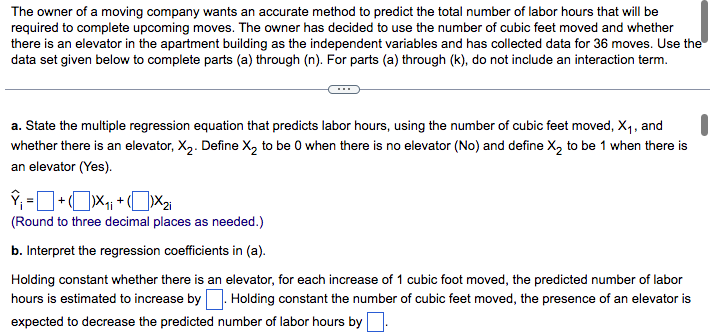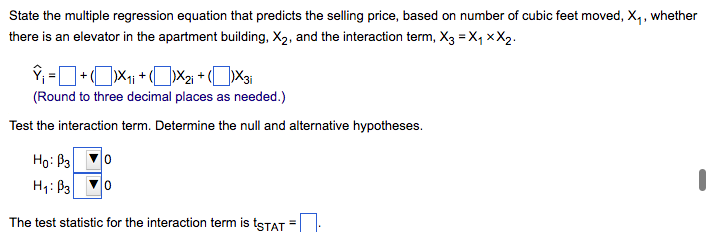The owner of a moving company wants an accurate method to predict the total number of labor hours that will be required to complete upcoming moves. The owner has decided to use the number of cubic feet moved and whether there is an elevator in the apartment building as the independent variables and has collected data for 36 moves. Use the data set given below to complete parts (a) through (n). For parts (a) through (k), do not include an interaction term. a. State the multiple regression equation that predicts labor hours, using the number of cubic feet moved, X₁, and whether there is an elevator, X₂. Define X₂ to be 0 when there is no elevator (No) and define X₂ to be 1 when there is an elevator (Yes). ŷ₁ = + (X₁₁ + (XX₂i (Round to three decimal places as needed.) b. Interpret the regression coefficients in (a). Holding constant whether there is an elevator, for each increase of 1 cubic foot moved, the predicted number of labor hours is estimated to increase by. Holding constant the number of cubic feet moved, the presence of an elevator is expected to decrease the predicted number of labor hours by
Include TSTAT and PVALUE
Hours Cubic Feet Elevator
28.00 546 No
19.50 402 No
26.25 564 No
25.00 549 No
9.00 213 Yes
20.00 338 Yes
21.00 559 Yes
11.25 338 Yes
40.00 900 Yes
12.00 280 Yes
33.75 855 Yes
40.00 830 Yes
19.50 338 Yes
24.00 362 No
31.00 754 No
29.00 658 No
24.00 421 No
11.00 273 Yes
23.00 557 Yes
45.00 1027 Yes
29.00 789 Yes
28.00 529 No
18.00 563 Yes
13.50 312 Yes
37.00 761 No
35.00 602 No
34.00 789 Yes
25.00 569 Yes
31.00 494 Yes
29.00 698 No
40.00 1050 Yes
27.00 483 Yes
13.00 432 Yes
65.50 1252 No
48.75 986 Yes
79.50 1398 No


Trending now
This is a popular solution!
Step by step
Solved in 6 steps with 21 images






